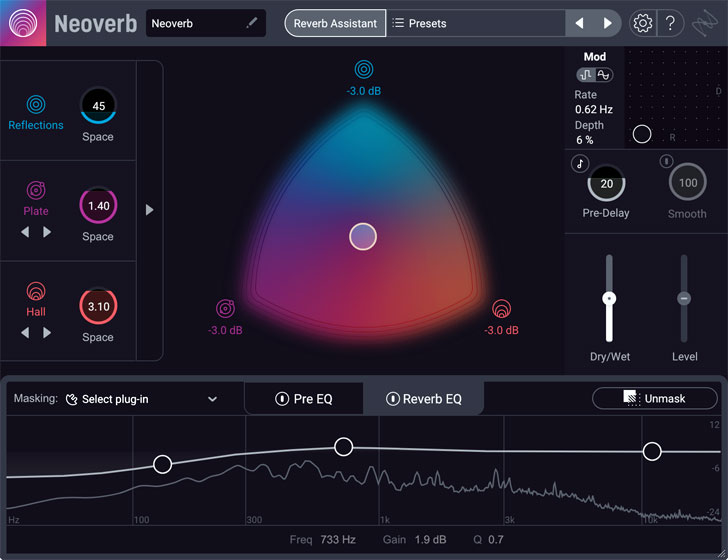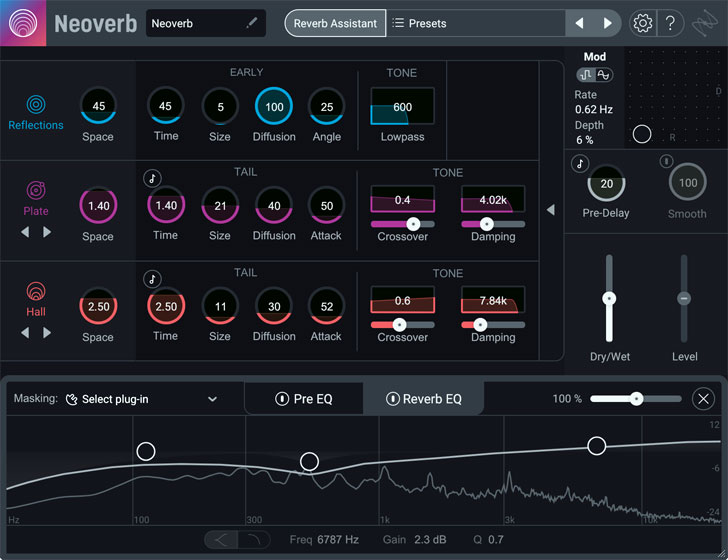|
|
iZotope Neoverb
|
|
|
 |
| iZotope Neoverb Main GUI |
 |
| iZotope Neoverb Advanced Controls |
Neoverb is a new reverb plug-in that uses three reverb synthesizers or engines and artificial intelligence (AI) to assist in programming reverberation according to your specific directives. There is Exponential Audio's Reflections Engine that creates the discrete and important early first reflections and echoes. Next are reverbs 2 and 3 that will vary in type depending on the preset and/or how you program Neoverb. There are rooms, plates, small and large echo chambers, and halls in addition to the Reflections.
The is a new idea for a single reverb plug-in because you can mix between the three by click/dragging a blue orb over an "Ouija Board" planchette--a small heart-shaped triangular area called a blend pad. An icon representing each of the three reverbs is located at a corners of the blend pad with the ability to morph or mix between them easily.
Clicking on the Advanced Controls panel's disclosure arrow reveals 17 additional parameters available for all three reverb engines. Well explained in the tutorials, these parameters all change depending on the preset selected and, of course, you can re-sculpt the sound infinitely. I liked the Input Smoothing feature that compresses transients to reduce spikey attacks in the reverb's tail ring out.
Always a good sign for plug-in software, Neoverb comes with 100 presets arranged in eight banks categorized by usage including one bank to store your own collection.
What easily could be quite daunting when you first open Neoverb is made less so by using the Reverb Assistant--Neoverb's assistant technology. The Reverb Assistant window opens with four general directives you provide when conceptualizing and defining a reverb's basic sound quality and character.
Reverb Assistant Window
The window opens with the Style cross-fader that ranges from Realistic--i.e. natural ambiences to Dramatic or unnatural ambiences. Dramatic usually means large, impressive spaces. Next, select the important Size parameter that ranges from: XS or extra small to Small, Medium, Large, and XL or extra Large.
The Wet/Dry control should be at 100% wet if you send from an Aux send bus. But I got into using Neoverb as an inserted stereo plug-in to realize its full potential. As an insert, I did notice that the dry signal is very much louder when 100% dry so I came to settling on the exact sound before doing any automation moves or dynamics processing--especially for lead vocals.
The last directive is Tone or the general overall coloration of the reverb sound with Clean, Dark, Bright, and Airy choices. Size and Tone are super-important settings for Reverb Assistant to do its best work. I would save various iterations of presets as I develop mixes.
Once you determine these desired choices in the Reverb Assistant window, play a section of the source audio for Neoverb to analyze and, in a few seconds, a reverb sound based on your guiding directives will be setup.
Unless I was going for something very wacky and strange, I found that this works amazingly well. For lead vocals, I might try this process on several different sections and save them as presets--verse, chorus, bridge etc. Otherwise, it is fast and usually I only had to re-adjust the Wet/Dry balance after hearing it mixed with the track.
EQ And Masking
Just below the Blend Pad, Neoverb has two, three-band equalizers. Pre-EQ 'carves' the incoming signal to reduce certain frequencies to prevent certain frequencies from building up in the reverb's sound. You can roll off low frequencies for drums or cut high frequencies for excessively bright vocals where sibilants will splash in the reverb. Auto-cut mode uses AI to carve the three-band parametric equalizer based on your original choices in Reverb Assistant. For a drum reverb this worked wonders! Reverb EQ comes post or after the reverb and makes suggestions based on minimizing the masking of other frequencies present in the source coming into Neoverb. A drop down menu allows seeing masking relative to any other tracks in your session with either Neoverb, Neutron 3, Nectar 3, VocalSynth or Relay iZotope processors inserted. The Masking Meter glows white in frequency regions where potential masking is happening.
For example I used Neoverb on a stereo sub-master mix of four electric guitar tracks and check for masking on an instance of Nectar 3 on a stereo pair of acoustic guitars. By just seeing the areas of slight conflict, I could adjust the Reverb EQ immediately on the electrics. I think this is a good start for this process and I'm hoping for more advancement in subsequent versions of Neoverb.
Neoverb is also a part of newly released Music Production Suite 4, which also includes RX 8 Standard, Ozone 9 Advanced, Neutron 3 Advanced, Nectar 3 (with Melodyne 5 essential), Insight 2, NIMBUS by Exponential Audio, and Tonal Balance Control 2. It sells on its own at $199 MSRP.
www.izotope.com/en/products/neoverb.html
|
|
|